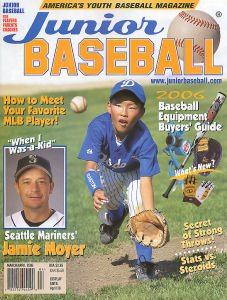JUNIOR BASEBALL: Learning the Game

This morning I'm looking through the pages of a magazine I can viscerally relate to, at least through the foggy lens of memory. It's Junior Baseball, a bimonthly published in Canoga Park, CA that should appeal to young persons who play the game, and to their parents and coaches as well.
My baseball-playing days were in Little League on Long Island in the mid-1950s. You could participate in the village's system from ages 8 to 12. I remember fondly the incredible excitement of putting on a real uniform (scratchy wool at the time) and playing at night under lights. And there are the traumatic memories, such as the night I was out in left field. The fence was just over four feet high, and that was probably the height of the batter. I still remember his name: Castoldi. He hit a high fly ball to left, and I went back, back, back, right up against the fence. I reached up with both hands, caught the ball, and suddenly it wasn't there any more. I had dropped it over the fence!
I also remember my last time at bat in my final season of Little League. I had been a fairly successful left-handed spray hitter, specializing in line drives to the opposite field. As I was up at bat, the umpire―an old family friend―broke every rule of impartial officiating and gave me advice on where to plant my feet. And darned if I didn't pull a deep fly ball to right field, probably the best-struck ball I had ever hit. As I've watched baseball in stadiums and on television over the years, I've often wondered whether that kind of knowledgeable advice a couple of years earlier would have led to a more prolonged baseball career.
Which brings us back to Junior Baseball, which is filled with good fundamental advice. A recent issue now in our newsstand has a column (for players aged 5-8) on various techniques for making stronger throws from the outfield, another (for players 9-13) on coping with pitching in cold weather, and yet another (for players 14-17) on exercises for preparing for the start of the season.
There's an article on the dangers of steroids, a profile of a successful traveling team of kids from Wayne County, MI, and an interview with Seattle pitcher Jamie Moyers. I found interesting an article on eye protection for baseball players, not only from traumatic injury, but also from ultraviolet light in dry climates such as Southern California, which can cause a dangerous eye condition called pterygium. Goggles with UV protection are recommended. There's also a useful column for coaches suggesting that selection or election of team captains can bring an added level of peer leadership to a team.
The game for kids has changed dramatically from what I knew: the magazine is filled with ads for aluminum bats (some for more than $300!), radar guns to tell you how fast you are pitching, and all sorts of instructional videos. There are expensive instructional camps, often run by former pro players, and traveling leagues made up of elite teams that play other good teams in a wide geographic region and that are apparently cutting into the player pool for regular junior baseball activities.
But baseball is still fundamentally about hitting and throwing the ball, and it's often the first organized sports activity that children encounter. As Junior Baseball editor and publisher Dave Destler writes in the issue, "The experience a kid has at the most basic, beginning levels of baseball determines whether he will want to go on and continue playing next season. . .or if he will exchange his baseball cleats for soccer cleats. Or a Game Box."
An annual subscription (six issues) to Junior Baseball is $17.70 from the publisher. We'll send you a sample copy for $2.59.


0 Comments:
Post a Comment
<< Home